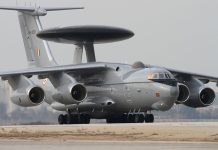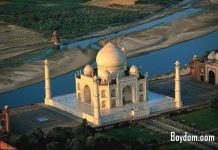Indian Navy is one of the elite forces of the Indian Armed Forces. It is headed by the Chief of Naval Staff who is an Admiral. Here are 35 Interesting Facts about Indian Navy.
1-5
1. Evolution of Indian Navy: India has a maritime history dating all the way back to 7,600 years. The first tidal dock in India is estimated to have been built at Lothal (Gujarat) around 2300 BC during the Indus Valley Civilization. The earliest known reference to an organisation dedicated to ships in ancient India is to the Mauryan Empire of 4th century B.C. Powerful navies included those of the Maurya, Satavahana, Gupta, Chola, Pandya, Vijayanagara, Kalinga, Mughal and Maratha empires. The Maratha naval power dominated the military scene in India for three centuries.
2. During the 17th and 18th centuries, the Maratha and Kerala fleets were expanded, and became the most powerful Naval Forces in the subcontinent, defeating European Navies at various times. The fleet review of the Maratha navy took place at the Ratnagiri fort in which the ships Gurabs, Galbat, Pal & small ships called as “Sangmeshwari” participated. The ‘Pal’ was a three masted fighter with guns peeping on the broadsides. Kanhoji Angre and Kunjali Marakkar, the Naval chief of Saamoothiri, were two notable naval chiefs of the period.
3. Later In 1612, the English East India Company established the East India Company’s Marine to protect its merchant shipping off the Gulf of Cambay and up the Narmada and Tapti rivers. Its first fighting ships in India were acquired on 5 September 1612. This force evolved into Her Majesty’s Indian Navy in 1830, while most of India was under British rule. Navy at this time had British officers and Indian sailors. The Indian Navy saw action in the First Opium War of 1840 and in the Second Anglo-Burmese War in 1852. During World War I, the force then known as the Royal Indian Marine undertook minesweeping, as well as supply and support operations for the Allies.
4. During 20th century Sub Lieutenant D. N. Mukherji was the first Indian to be granted a commission as an engineer officer in 1928. In 1934, the navy was renamed as the Royal Indian Navy (RIN). The onset of World War II led to an expansion in numbers of vessels and personnel. The navy was actively involved in operations during the war around the world.
5. At the end of the World War II, the navy underwent rapid, large-scale demobilisation of vessels and personnel. In 1946, Indian sailors started the Royal Indian Navy Mutiny, a rebellion on board ships and on shore establishments to protest discrimination against Indian officers and sailors by the British. A total of 78 ships, 20 shore establishments and 20,000 sailors were involved in the rebellion, which spread all over India.
6-10
6. After Independence, the committee allocated to the newly-formed ‘Royal Pakistan Navy’ (RPN) three of the seven active sloops, HMIS Godaveri, HMIS Hindustan and HMIS Narbada, four of the ten serviceable minesweepers, two frigates, two naval trawlers, four harbour launches and a number of harbour defence motor launches. 358 personnel, and 180 officers, most of whom were Muslims or Europeans, volunteered to transfer to the RPN. India retained the remainder of the RIN’s assets and personnel, and many British officers opted to continue serving in the RIN
7. When India became a republic on 26 January 1950, the Royal prefix was dropped and the name Indian Navy was officially adopted. The prefix on her ships was changed to Indian Naval Ship (INS).
8. Indian Navy’s currently active ships include nuclear powered submarine INS Chakra (INS Arihant soon to be deployed in 2013), 14 diesel powered submarines, 1 aircraft carrier (another one to be deployed in 2013), 1 amphibious ships, 9 landing ships, 23 destroyer and frigates, 24 corvettes, 7 mine countermeasure ships, 30 patrol vessels, 4 replenishment ships, 6 support ships, 10 research and survey vessels and 4 training vessels.
9. Apart from the vessels, Indian Navy operates 32 fighter aircrafts, 14 patrol and surveillance aircrafts, 20 utility aircrafts, 16 trainer aircrafts and 107 helicopters.
10. December 7 is celebrated as Navy Day.
11-15
11. INS Vikramaditya: Modified Kiev class aircraft carrier (ex-Admiral Gorshkov) due to enter into service October 2013.
12. INS Viraat: Centaur class aircraft carrier (ex-HMS Hermes) has been in service since 1987.
13. The HMS Harriers (airplanes on INS VIRAAT) are one of its kind, which have the ability of vertical landing and take-off.
14. INS Vikrant: Majestic-class carrier, (ex-HMS Hercules) was the first aircraft carrier of India, in service from 1961 to 1997 and is currently a museum ship docked at Mumbai.
15. INS Vikrant: A 40,000 ton Vikrant class carrier is being built at Cochin Shipyard and is expected to enter service in 2017.
16-20
16. India’s INS-ARIHANT is the first indigenously build nuclear powered submarine in India. Thereby it is limited not by its fuel, but its ability to carry food for its men. It has the capability to shoot missiles tipped with nuclear warheads even from a depth of 0.5 km beneath the sea.
17. India is the only country in the world to operate submarine launched supersonic cruise missiles.
18. INS Vishal: 65,000 ton Vikrant-class carrier is being built and expected to enter service in 2025.
19. Indian Navy’s INS Prahar was the fastest missile boat in the world. On April 22, 2006 INS Prahar collided with a container ship MV Rajiv Gandhi, and sank off the coast of Goa. No one was injured in the accident. The commanding officer of the ship, Lieutenant Commander Yogesh Tripathi was found guilty of negligence by an Indian Navy court-martial, and dismissed from service
20. The rank of Admiral of the Fleet exists in Indian Navy, but it is primarily intended for major wartime use and honour. No officer of the Indian Navy has yet been conferred this rank.
21-25
21. Indian Navy ranks 5th in the world in terms of firepower and personnel strength.
22. The Indian Navy is the only navy to operate a full functioning aircraft carrier in waters surrounding the Indian subcontinent.
23. The Ezhimala Naval Academy in Kerala is the largest of its kind in Asia.
24. To keep pace with expanding electronic communication, the navy has installed high tech equipment to detect, identify, intercept and categorize various classes of frequencies, carrier waves and pulses. The navy has chip radars and frequency deconstruction tools. The launch of Navy Enterprise Wide Network is imminent and this step will help in better coordination and training among the naval bases and between the onshore facilities with ships.
25. The Indian Navy has bases located in Mumbai, Kochi, Visakhapatnam, Goa, Chennai, Pune, Coimbatore, Chilka and Port Blair. The Naval Headquarters is in New Delhi.
26-30
26. It is hard to imagine the Indian Navy employing commandos. After all, commands are more at home with the Army, on land. However, the Naval forces train special commandos, MARCOS. MARCOS are elite special operations unit that are heavily specialized for maritime operations, but not only are they equally capable in all other kinds of operations, they have also undertaken very covert operations in very hostile situations on foreign soils, beyond their domain of specialization. Very few know that MARCOS were utilized in the Kargil war for operations beyond Pakistani positions, the exact purpose of which remains classified. Currently the MARCOS are highly active in Jammu & Kashmir. Their main task is to prevent the infiltration of terrorists from Pakistan through Jhellum river and Wular lake. There are very few units in the world qualified to jump into water as well jump out of aircrafts with full combat load. The MARCOS can be deployed from Aircrafts, Ships and Submarines in full battle gear. The MARCOS alongside the Indian Army’s Para Commandos also use the most advanced and sophisticated weapon systems in entire Indian Armed Forces.
27. The Indian Navy will acquire at least five ships every year for the next 10 years.
28. Indian Navy employs 58,350 active personnels.
29. INS Baaz is the southernmost air station of the Indian Armed Forces based in Andaman and Nicobar Command that overlooks the Strait of Malacca as well as the Six-degree channel between Great Nicobar and the Indonesian island of Sumatra.
30. India is emerging as a powerful country capable of possessing a nuclear triad (strategic bombers, intercontinental ballistic missiles, and submarine-launched ballistic missiles).
31-35
31. The Indian Naval ensign first flew in Antarctica in 1981. The Indian Navy succeeded in Mission Dakshin Dhruv 2006 by traversing to the South Pole on skis. With this historic expedition, they have set the record for being the first military team to have successfully completed a ski traverse to the Geographic South Pole. Indian Navy became the first organisation to reach the poles and Mt.Everest.
32. Lt. Cdr. M.S. Kohli led the Indian Navy’s first successful expedition to Mount Everest in 1965; the Navy’s ensign was again flown atop Everest on 19 May 2004 by a similar expedition.
33. An Indian Navy team comprising 11 members successfully completed an expedition to the Arctic pole.
34. Cdr. Dilip Donde completed the first solo circumnavigation by an Indian citizen on 22 May 2010.
35. The Indian Navy is setting up a naval station in Madagascar to monitor and patrol the coast of Mozambique as well as the southern Indian Ocean. The Indian Navy also has berthing rights in Oman and Vietnam.







































